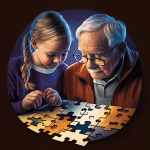
Play is an essential part of childhood, providing children with opportunities to learn, grow, and develop crucial life skills. For children with autism spectrum disorder (ASD), play can also serve as a powerful tool in their therapeutic journey. In this blog post, we will explore how various therapeutic approaches, such as Applied Behavior Analysis (ABA), speech therapy, and occupational therapy, can integrate play into their sessions to create enjoyable and effective experiences for children with autism.
- Applied Behavior Analysis (ABA) and Play
ABA is a widely recognized evidence-based therapy for children with autism, focusing on improving specific behaviors, social skills, and communication (National Autism Center, 2015). By incorporating play into ABA sessions, therapists can create a fun and engaging environment that motivates children to participate in the learning process.
For example, therapists can use a child’s favorite toy or game as a reinforcer to encourage them to complete a task or exhibit a desired behavior (Cooper, Heron, & Heward, 2020). Additionally, ABA therapists can integrate social games, such as “Simon Says” or “Red Light, Green Light,” to teach social skills, turn-taking, and following instructions (Leaf et al., 2016).
- Speech Therapy and Play
Speech therapy plays a vital role in improving communication skills in children with autism, addressing issues such as articulation, language development, and social communication (ASHA, 2021). Play-based activities can create a natural context for language learning and make speech therapy sessions more enjoyable for the child.
For instance, a speech therapist might use a game of “I Spy” to help a child practice new vocabulary words or create a pretend-play scenario that encourages the use of target phrases and social communication skills (Paul & Norbury, 2012). Board games, puzzles, and storytelling activities can also facilitate language development and engage children in a fun, interactive way (Girolametto et al., 2007).
- Occupational Therapy and Play
Occupational therapy aims to help children with autism develop the skills needed for everyday tasks and activities, focusing on areas such as sensory integration, fine motor skills, and self-care (AOTA, 2021). Play is a natural fit for occupational therapy, as it allows children to practice these skills in a fun and motivating context.
Sensory play activities, such as playing with sand, water, or playdough, can help children with autism become more comfortable with different textures and sensations (Case-Smith et al., 2015). Play-based fine motor activities, such as stringing beads, building with blocks, or manipulating playdough, can help children develop hand-eye coordination and dexterity (Cermak et al., 2010). Therapists can also incorporate role-play scenarios, like setting the table or getting dressed, to practice self-care skills in a playful and engaging manner (Kuhaneck & Britner, 2013).
Conclusion
Incorporating play into therapy sessions can create a positive and motivating environment for children with autism, making the learning process more enjoyable and effective. By integrating play into ABA, speech therapy, and occupational therapy, therapists can support the development of crucial skills while fostering a sense of fun and enjoyment in the therapeutic process.
References
AOTA (2021). Occupational Therapy’s Role with Autism. American Occupational Therapy Association. Retrieved from https://www.aota.org/
ASHA (2021). Autism. American Speech-Language-Hearing Association. Retrieved from https://www.asha.org/
Case-Smith, J., Weaver, L. L., & Fristad, M. A. (2015). A systematic review of sensory processing interventions for children with autism spectrum disorders. Autism, 19(2), 133-148.
Cermak, S. A., Curtin, C., & Bandini, L. G. (2010). Food selectivity and sensory sensitivity in children with autism spectrum disorders. Journal of the American Dietetic Association, 110(2), 238-246.
Cooper, J. O., Heron, T. E., & Heward, W. L. (2020). Applied behavior analysis. Pearson.
Girolametto, L., Weitzman, E., Wiigs, M., & Pearce, P. S. (2007). The relationship between maternal language measures and language development in toddlers with expressive vocabulary delays. American Journal of Speech-Language Pathology, 16(3), 260-270.
Kuhaneck, H. M., & Britner, P. A. (2013). A preliminary investigation of the relationship between sensory processing and social play in autism spectrum disorder. OTJR: Occupation, Participation, and Health, 33(3), 159-167.
Leaf, J. B., Dotson, W. H., Oppenheim, M. L., Sheldon, J. B., & Sherman, J. A. (2016). The effectiveness of group teaching interactions for young children with autism. Behavior Analysis in Practice, 9(1), 3-11.
National Autism Center (2015). Findings and conclusions: National standards project, phase 2. National Autism Center.
Paul, R., & Norbury, C. (2012). Language disorders from infancy through adolescence: Listening, speaking, reading, writing, and communicating. Elsevier Health Sciences.
By integrating play into ABA, speech therapy, and occupational therapy, practitioners can create a more enjoyable experience for children with autism, which may ultimately lead to better therapeutic outcomes.




